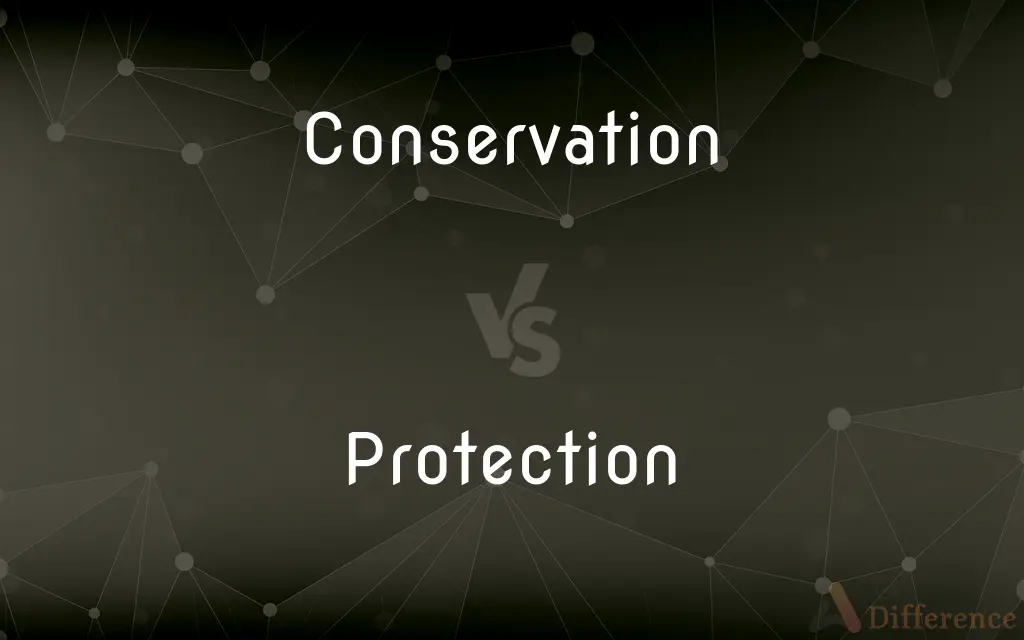Conservation vs. Protection — What's the Difference?
By Tayyaba Rehman & Maham Liaqat — Updated on April 2, 2024
Conservation involves sustainable management of natural resources, while protection focuses on preserving environments from harm.

Difference Between Conservation and Protection
Table of Contents
ADVERTISEMENT
Key Differences
Conservation is the practice of using natural resources in a sustainable manner to ensure their long-term viability. It encompasses the careful management and use of forests, water, and wildlife, aiming to balance human needs with the health of ecosystems. Whereas, protection is more about preserving natural environments and wildlife from destructive activities. It involves creating protected areas like national parks and reserves where human activity is limited or strictly regulated.
While conservation recognizes the value of natural resources for human use and aims to manage them wisely for future generations, protection prioritizes the safeguarding of nature from human exploitation. Conservation strategies may include controlled logging, fishing quotas, and sustainable agriculture practices. On the other hand, protection efforts often result in the establishment of wildlife sanctuaries, biodiversity hotspots, and other areas where ecosystems are maintained in their natural state with minimal human interference.
Conservation often involves scientific, economic, and social considerations to maintain ecosystem services such as air and water purification, soil fertility, and pollination. It seeks to harmonize human activities with the natural world, encouraging responsible use and management of natural resources. Conversely, protection is driven by the imperative to shield ecosystems and species from threats like pollution, habitat destruction, and overexploitation, sometimes foregoing economic benefits for ecological stability.
Both conservation and protection are essential for maintaining biodiversity and ensuring the health of the planet. Conservation’s approach is proactive, focusing on sustainable use and management, while protection takes a more defensive stance, aiming to preserve ecosystems in their current state or restore them to a previous state.
Conservation can involve measures to restore ecosystems, its primary focus is on the sustainable use of natural resources. Protection, in contrast, can involve active interventions to repair damaged ecosystems but is more focused on preventing further harm and maintaining current conditions.
ADVERTISEMENT
Comparison Chart
Objective
Sustainable use and management of natural resources
Preservation of environments and species
Activities
Sustainable logging, fishing, agriculture
Establishing reserves, limiting human activities
Focus
Balance between use and preservation
Shielding from exploitation and damage
Considerations
Scientific, economic, social
Ecological stability, species preservation
Outcome
Long-term viability of resources
Maintenance or restoration of natural states
Compare with Definitions
Conservation
Practices that support the sustainable harvesting of wildlife.
Fish conservation strategies include setting quotas to prevent overfishing.
Protection
Initiatives to prevent pollution and environmental degradation.
Air quality protection involves regulating emissions to preserve clean air.
Conservation
Efforts aimed at maintaining ecosystem services.
Water conservation measures help ensure a sustainable water supply for agriculture.
Protection
Actions to preserve natural landscapes and ecosystems.
Wetland protection efforts prevent the drainage and development of wetland areas.
Conservation
The principle of using resources wisely to benefit future generations.
Energy conservation reduces dependency on fossil fuels and promotes renewable energy sources.
Protection
Policies and regulations aimed at minimizing human impact on the environment.
Land use protection policies restrict development in sensitive ecological areas.
Conservation
The sustainable management and use of natural resources.
Forest conservation involves regulated logging to prevent deforestation.
Protection
Efforts to maintain areas free from human development and exploitation.
Marine protected areas safeguard marine biodiversity by restricting fishing and drilling.
Conservation
Activities that reduce environmental impact and support biodiversity.
Using conservation tillage techniques reduces soil erosion and supports soil health.
Protection
Legal measures to preserve endangered species and habitats.
The Endangered Species Act provides legal protection for species at risk of extinction.
Conservation
The act or process of conserving.
Protection
Protection is any measure taken to guard a thing against damage caused by outside forces. Protection can be provided to physical objects, including organisms, to systems, and to intangible things like civil and political rights.
Conservation
Preservation or restoration from loss, damage, or neglect
Manuscripts saved from deterioration under the program of library conservation.
Protection
The act of protecting.
Conservation
The protection, preservation, management, or restoration of wildlife and of natural resources such as forests, soil, and water.
Protection
The condition of being protected.
Conservation
The maintenance of a physical quantity, such as energy or mass, during a physical or chemical change.
Protection
One that protects
Wore gloves as a protection against cold.
Saw darkness as their protection in trying to escape.
Conservation
The act of preserving, guarding, or protecting; the keeping (of a thing) in a safe or entire state; preservation.
Protection
A pass guaranteeing safe-conduct to travelers.
Conservation
Wise use of natural resources.
Protection
Something that lowers the risk of pregnancy or infection, especially the use of a condom.
Conservation
(biology) The discipline concerned with protection of biodiversity, the environment, and natural resources
Protection
Payment collected by racketeers from businesses or illegal enterprises under threat of violence.
Conservation
(biology) Genes and associated characteristics of biological organisms that are unchanged by evolution, for example similar or identical nucleic acid sequences or proteins in different species descended from a common ancestor
Protection
Payment made by racketeers to officials or law enforcement to avoid arrest or prosecution.
Conservation
(culture) The protection and care of cultural heritage, including artwork and architecture, as well as historical and archaeological artifacts
Protection
The process of keeping (something or someone) safe.
Raincoats give protection from rain.
Conservation
(physics) lack of change in a measurable property of an isolated physical system (conservation of energy, mass, momentum, electric charge, subatomic particles, and fundamental symmetries)
Protection
The state of being safe.
Conservation
The act of preserving, guarding, or protecting; the keeping (of a thing) in a safe or entire state; preservation.
A step necessary for the conservation of Protestantism.
A state without the means of some change is without the means of its conservation.
Protection
A means of keeping or remaining safe.
Conservation
An occurrence of improvement by virtue of preventing loss or injury or other change
Protection
(insurance) Coverage.
Conservation
The preservation and careful management of the environment and of natural resources
Protection
Immunity from harm, obtained by illegal payments, as bribery or extortion.
Conservation
(physics) the maintenance of a certain quantities unchanged during chemical reactions or physical transformations
Protection
(obsolete) A document serving as a guarantee against harm or interference; a passport.
Protection
(economics) Restrictions on foreign competitors which limit their ability to compete with domestic producers of goods or services.
Protection
(computing) An instance of a security token associated with a resource (such as a file).
Protection
The act of protecting, or the state of being protected; preservation from loss, injury, or annoyance; defense; shelter; as, the weak need protection.
To your protection I commend me, gods.
Protection
That which protects or preserves from injury; a defense; a shield; a refuge.
Let them rise up . . . and be your protection.
Protection
A writing that protects or secures from molestation or arrest; a pass; a safe-conduct; a passport.
He . . . gave them protections under his hand.
Protection
A theory, or a policy, of protecting the producers in a country from foreign competition in the home market by the imposition of such discriminating duties on goods of foreign production as will restrict or prevent their importation; - opposed to free trade.
Protection
The activity of protecting someone or something;
The witnesses demanded police protection
Protection
A covering that is intend to protect from damage or injury;
They had no protection from the fallout
Wax provided protection for the floors
Protection
Defense against financial failure; financial independence;
His pension gave him security in his old age
Insurance provided protection against loss of wages due to illness
Protection
The condition of being protected;
They were huddled together for protection
He enjoyed a sense of peace and protection in his new home
Protection
Kindly endorsement and guidance;
The tournament was held under the auspices of the city council
Protection
The imposition of duties or quotas on imports in order to protect domestic industry against foreign competition;
He made trade protection a plank in the party platform
Protection
Payment extorted by gangsters on threat of violence;
Every store in the neighborhood had to pay him protection
Common Curiosities
What is the main goal of conservation?
To ensure sustainable use and management of natural resources for future generations.
Can a conservation effort also include protective measures?
Yes, conservation efforts can include protective measures as part of a strategy to manage natural resources sustainably.
How are conservation priorities determined?
Priorities are often determined by factors such as the level of threat to a species or habitat, its ecological importance, and potential for recovery.
How does protection differ from conservation in terms of human activity?
Protection often involves restricting human activities to prevent harm, while conservation seeks to balance human use with the health of ecosystems.
How do conservation and protection contribute to fighting climate change?
They help mitigate climate change by preserving and restoring ecosystems that absorb carbon dioxide, such as forests and wetlands.
Why is protection important for biodiversity?
Protection is crucial for maintaining biodiversity by safeguarding habitats and species from threats like habitat destruction and pollution.
What role do national parks play in conservation and protection?
National parks play a dual role by conserving landscapes and ecosystems for public enjoyment and protecting them from development and exploitation.
Is conservation always beneficial to wildlife?
While conservation aims to be beneficial, its success can vary depending on how well it balances human needs with wildlife conservation.
Why is public awareness important for conservation and protection?
Public awareness is crucial for gaining support for conservation and protection efforts, encouraging sustainable behaviors, and influencing policy.
Can protection measures be temporary?
Yes, some protection measures, like seasonal wildlife protection areas, may be temporary to address specific threats or life cycle needs.
How do international agreements contribute to conservation and protection?
They provide a framework for global cooperation on issues like wildlife trafficking, habitat preservation, and climate change mitigation.
What challenges do conservationists face?
Challenges include balancing economic development with environmental sustainability, combating illegal activities, and adapting to climate change.
How do local communities contribute to conservation and protection?
Local communities can contribute through practices like community-managed forests, sustainable agriculture, and participation in conservation initiatives.
How does urban planning interact with conservation and protection efforts?
Urban planning interacts by integrating green spaces, wildlife corridors, and sustainable practices to reduce environmental impacts.
What is the difference between a wildlife sanctuary and a national park?
Wildlife sanctuaries primarily focus on protecting species and habitats, while national parks aim to conserve scenic, natural, and historic areas for education and recreation.
Share Your Discovery

Previous Comparison
Hazelcast vs. Redis
Next Comparison
Test vs. ExamAuthor Spotlight
Written by
Tayyaba RehmanTayyaba Rehman is a distinguished writer, currently serving as a primary contributor to askdifference.com. As a researcher in semantics and etymology, Tayyaba's passion for the complexity of languages and their distinctions has found a perfect home on the platform. Tayyaba delves into the intricacies of language, distinguishing between commonly confused words and phrases, thereby providing clarity for readers worldwide.
Co-written by
Maham Liaqat













































